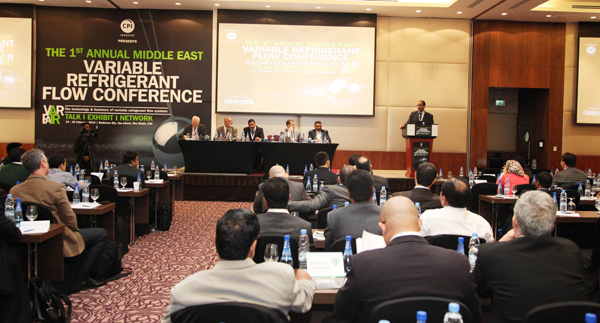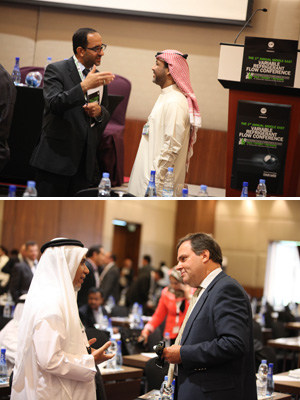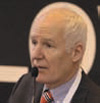We bring you Part II of our report on the 1st Annual Middle East VRF Conference, where a wide range of issues were discussed.
In the absence of “suitable” alternatives to the refrigerants now in use, the industry may need to content itself with using the known “devil”. We bring you Part II of our report on the 1st Annual Middle East VRF Conference, where a wide range of issues were discussed.

One of the key takeaways from the discussions at the 1st Annual Middle East VRF Conference held on February 24 and 25 at the Radisson Blu at Yas Island, Abu Dhabi, was that no single route or a “magic solution” emerged to move away from HCFCs.
HCFCs – which are fast being phased out due to their ozone-depleting potential (ODP) – are being replaced by HFCs in many applications. However, due to their high global warming potential (GWP), HFCs are also in the process of being phased down. In fact, a recently proposed amendment to the Montreal Protocol dictates that HFC usage should be decreased to 20% in 2040 in both developed and developing countries.
In light of the heightened urgency to find viable alternatives to HCFCs, Eng Yaqoub Almatouq, Refrigerants Expert from Kuwait, says that the industry now finds itself at a crossroads as finding suitable low-GWP, safe and environmentally sound alternatives to HCFCs is proving to be a challenging endeavour.
First, he points out that there is a lack of consensus on the interpretation of what “high” and “low” GWP means. There exists a table of parameters set by the Technological and Economic Assessment Panel (TEAP). But the same has not yet been approved or agreed upon.
Second, he explains there is a need for an overarching strategy to phase out HCFCs over the next two decades to address all end-users. The priority, he adds, should be on the sectors with the most feasible alternatives – those with low or no GWP characteristics.
Third, he says that there is a need for the government to address the challenge with an integrated approach at institutional and industry levels. He adds that the perceived absence of unified and coordinated policies and standards in linked markets like the GCC worsen the situation and offer opportunities for other countries to dump obsolete technologies in the region.
Lastly, the proposed alternatives to HCFCs like hydrocarbons (HCs), HFC blends and CO2 technologies have issues, as well. HCs, for example, have safety concerns, while HFC blends and CO2 technologies are still in research stages.
The industry’s quest to move away from HCFCs, has yielded several options which should be carefully studied, taking into account the specific needs and circumstances of the region. At present, however, says Almatouq, in the absence of “ideal” alternatives to HCFCs, the industry may need to settle for the “devil” it knows, R22, and try its best to keep the refrigerant inside the equipment to mitigate its environmental effect.
As part of our continuing extensive and comprehensive coverage of the 1st Annual Middle East VRF Conference, we bring you excerpts from the presentations of Eng Yaqoub Almatouq and from Justin Patrick, Director for Channel Marketing and Strategy, Johnson Controls in Milwaukee.
We also bring you the highlights from the first plenary discussions at the event, joined by Almatouq and Patrick, together with Dr Esam Elsarrag, Director, Gulf Organisation for Research and Development, (GORD-GSAS); George Kenich, Head, Infrastructure and MEP, Aldar Properties PJSC; Edwin Young, Program Manager, Estidama, Abu Dhabi Urban Planning Council; Ghaleb Abusaa, CEO, The Three Factors Company (en3 Solutions) and Erick Melquiond, Managing Director, Eurovent Certification Company.
 Eng Yaquob Almatouq (Refrigerants Expert, Kuwait)
Eng Yaquob Almatouq (Refrigerants Expert, Kuwait)
“The alternatives to R410A and R407A have high-GWP. So, they are not long-term alternatives, in any case. In my point of view, they will not stand so long, because they have high GWP…. R32 has another issue, because it’s mildly flammable. So, we have to be aware of those alternatives.
“Hydrocarbon is the best. But we have other issues concerning it. We have to be careful when using hydrocarbons. I think the problem regarding the use of hydrocarbons in air conditioning split unit is that the leakage is in the bedrooms and in the children’s rooms. It’s very difficult…. So, we have to be aware.
“I am only talking about the GCC countries, because we do not have the culture of safety. Yes, technologies are there, but we have to adopt the safety measures. Before we adopt the technologies, we have to make ourselves and our end-users ready to absorb these technologies. It is not wise to give the technologies and, then, ask them to learn by mistake. You have to adjust and educate them regarding the issues. We have to understand that flammability is an issue in our region….
“Do you know that in the six [GCC] countries, we don’t have a law regarding who can maintain air conditioning systems? In the morning, one can be a teacher, and in the afternoon, he can buy a gauge and a cylinder, and he can be an air conditioning technician….
 “Yes, they are venting the gas, because recovering the gas and going through procedures will take some time. Time is money for the technicians, because they only have six hours or seven hours before they sleep, so they can work on five or six houses. So, the easiest way is to cut the pipe, relieve it, and refill it for you….
“Yes, they are venting the gas, because recovering the gas and going through procedures will take some time. Time is money for the technicians, because they only have six hours or seven hours before they sleep, so they can work on five or six houses. So, the easiest way is to cut the pipe, relieve it, and refill it for you….
“There is a [proposed] amendment in our treaty now – coming from USA, Mexico, Canada, UK, EU, and some other countries – to phase down the use of HFCs starting 2015…. So we have this procedure…. How can you debate with the market saying that you will market something and after 10 years it will be reduced? Nobody can go to that and invest money, especially in the industry. This is really very aggressive. When it started, we were against that amendment. Kuwait, as well as the other GCC countries, is against it, because we don’t have alternatives. But, it is going very crucially and will be amended very soon.
“As GCC countries, we have HPMPs (HCFC Phase-out Management Plans) and all of the GCC countries have already submitted. Saudi Arabia and Bahrain were the last two countries to approve their HPMPs for 2020 last December…. Alternatives should be feasible, with no or low- GWP characteristics. They say that the alternatives are there. But when we want to adopt them in the region, they are not working. They are there, but we cannot use them….
“What is the situation in the region now [in terms of HCFC consumption]? It’s declining in Article 2 countries (USA and Europe). But it is increasing in our region. In the GCC countries, there is a huge increase….
“Now, we have to consider the market and the industry itself. Today, [when we talk about alternatives to HCFCs], we are no longer talking about the ozone. We want to adopt alternatives that are efficient, safe and environmentally sound. I do not get it, really. I spent 10 years in that treaty, but I did not get to understand the meaning of “environmentally sound”….
“There is no single route or magic solutions for the conversion away from HCFCs. We don’t understand, because today they say, ‘this is the alternative’, then we shift. Then, after two years, they will come and say ‘Oh, sorry this is also bad’. So the industry becomes agitated, and it no longer knows how to move.
“Currently, the best alternative is the refrigerant that I call ‘the devil we know’ – R22. Countries can keep the refrigerant for as long as they want, but they cannot import in excess. So, if they keep the refrigerant in the equipment, they can run for 100 years or 200 years without an issue. Let’s reduce the leakage in the equipment. Let’s motivate the engineers to build properly designed machines that don’t leak…. Until we find the alternatives, let’s deal with what we have now….”
 Justin Patrick (Director, Channel Marketing and Strategy, Johnson Controls, Milwaukee)
Justin Patrick (Director, Channel Marketing and Strategy, Johnson Controls, Milwaukee)
“Based on the extensive market research and customer analysis, Johnson Controls has determined that VRF is one of the fastest growing market offerings. It was a USD 8.5 billion market globally in 2012, and a half a billion dollar [market] in the US in the same timeframe …
“It’s a complete system. It’s sold with all the elements needed for heating, cooling and controlling it – and they’re designed to work together. This “complete system” aspect has benefits for everybody in the chain. Consulting engineers like it, because it saves them time in designing the system. Design-build contractors like it, because it gives them access to other buildings that they wouldn’t have had the ability or the skill set to design, and they could move into larger, more complex facilities. Because of the ease of system design and selection, the tools make a very complex system very easy to design. It’s a user-friendly and intuitive Microsoft Windows-looking interface, and it significantly lowers the amount of training that you need to have to use the tool. There’s no need to perform complex calculations to size the system. The automated tool guides you through the selection … and it makes the design that much easier.
“The simple and quick installation of it makes it a very modular approach. It allows you to quickly scale a building; it allows the building to be built in phases; and there’s a wide range of control systems that can go with it. The compact size of VRF systems allows the majority of components to be taken up a normal-sized elevator. The piping diameter of the refrigerant piping through the building is very small, and this reduces the labour component that’s needed to run through the building and the level of complexity in the skill set needed to include those, as well.
“It eliminates the need for additional building automation systems, because it comes as a complete control package. It doesn’t limit it, however, because there are very easy bridges that take the VRF systems and put it into BMS, which is also able to tie in with the more complex systems.
“The other thing that’s a great advantage to VRF is its efficiency. VRF is variable: It pushes refrigerants around with variable speeds; it has variable compressors and variable fans in most of the different areas. If no one is in a particular room, the VRF system will slow the fan down and slow the cooling or even shut off the different zones….
“Because of the design concept, VRF systems are adaptable to a pretty wide range of building applications. It’s used in Asia for new construction because of the speed with which it can be installed and for the phased deployment of those build-in build-out infrastructures. For buildings with no duct work or limited space, like those in North America and Europe, it’s the choice to go with, because it has small refrigerant lines and it’s easy to get into the different locations. The mix-and-match capability of it allows for different units to be held in stock and so that local inventory makes it easier for contractors to respond to replacement work or quick additions to the buildings….
“I don’t think that VRF is perfect, by the way – it has some limitations, as well. While the modular design is helpful for most buildings, there’s an economic limit to the scale of it. As you get to larger and larger systems, it just doesn’t make sense. In our preliminary investigations, it’s around 400 tonnes where chilled water systems really start to win out in the scale and efficiency of the building.
“Fresh air is another issue. A lot of manufacturers have added ducting and ducted units into their system and those are good up to a certain point. But, if you have a large building that requires a lot of air changes, an additional outside air unit is required to temper that air and keep the indoor air quality to the right levels.
“On building codes and safety, as Eng Almatouq discussed, we’re at a kind of an impasse, where we need to figure out what the next refrigerant is. VRF, Chillers and packaged equipment are all on the same boat as to what is the right choice of refrigerant. It’s the lesser evil out there, and so we still have to deal with that, but at this point R410A is kind of the winner when it comes to VRF systems.
“VRF is major growing factor in the HVAC industry, faster than others. Johnson Controls has invested in it, as most of the many other manufacturers…. There are concerns about this system, and we’ve worked to address those and there’s still more work to be done on that. What it comes down to, in my opinion, is having the right products at any one point in time.”
How many manufacturers do you think can provide products that perform 40%to 60% more than ASHRAE?
 Esam Elsarrag: The benchmark is 30%. One can choose to target 60% to gain a higher star rating or to claim more points in terms of energy. The zero is 30% less than ASHARE. But most of the buildings are achieving scores of approximately between one and two, or equivalent to 50% less than ASHRAE 90.1 2004.
Esam Elsarrag: The benchmark is 30%. One can choose to target 60% to gain a higher star rating or to claim more points in terms of energy. The zero is 30% less than ASHARE. But most of the buildings are achieving scores of approximately between one and two, or equivalent to 50% less than ASHRAE 90.1 2004.
Our idea is, when you cut the cooling need, you already meet the big chunk. Then, after that, you can go for efficient systems and so on. When you reduce the need for cooling, you will find out that, by default, you will make big cut compared to the ASHRAE level. We have tools that you can use to assess your design.
Does GSAS ask for performance tests from independent laboratories to verify the performance and the COP of systems?
Esam Elsarrag: Yes, there will be verification for the COP and there will be a lab test. We have international labs, as well. It will not be a very difficult process. We have approved third-party laboratories all over the world. Then, we will get the certificate, and then we’ll come back and approve your system. Within a year, this system will be in place.
Why is it important to take into consideration the seasonal COP and overall COP of the system in evaluating its energy efficiency?
Esam Elsarrag: When we developed the energy tools for GSAS, we meant to go through the seasonal energy efficiency, because we are talking about the annual energy consumption. So, when you talk about the annual energy consumption, you have to talk about the seasonal energy efficiency ratio. Because we are adopting the EN ISO standards, the definitions available (BTU/tone, BTU/kw) will not work with GSAS. So we have to be concerned with the European energy efficiency ratio definitions….
In your presentation, you mentioned about the pipe length which, you said, can reach up to 950 feet. How about vertical lift? How much can we go up to?
 George Kenich: We do not have much information on the manometric height. Definitely, the vertical [lift] counts a lot for the manometric height and the pressure down that we are putting on our compressors inside. As an engineer, I will try to find out how much is the pressure of the load which I am applying to the compressor just so not to make the compressor work on high load continuously. It is mostly a question of energy efficiency.
George Kenich: We do not have much information on the manometric height. Definitely, the vertical [lift] counts a lot for the manometric height and the pressure down that we are putting on our compressors inside. As an engineer, I will try to find out how much is the pressure of the load which I am applying to the compressor just so not to make the compressor work on high load continuously. It is mostly a question of energy efficiency.
Does Estidama take care of the recycling and recovery of the refrigerants?
 Edwin Young: As far as Estidama is concerned, it has an operational rating which is being finalised as of the moment. As part of the operational rating system, we will control the use of refrigerants. As of the moment, there is no control in the Gulf region…. We have concerns about leakage; ODP is just one part of it, GWP is more important. The HFCs that we have right now and are available to us are the best that the industry can provide. It will change in the future, but now we have to control that. The best way to control GWP is to not let the systems leak. We need to make sure that the installation is correct.
Edwin Young: As far as Estidama is concerned, it has an operational rating which is being finalised as of the moment. As part of the operational rating system, we will control the use of refrigerants. As of the moment, there is no control in the Gulf region…. We have concerns about leakage; ODP is just one part of it, GWP is more important. The HFCs that we have right now and are available to us are the best that the industry can provide. It will change in the future, but now we have to control that. The best way to control GWP is to not let the systems leak. We need to make sure that the installation is correct.
How will you cover a fresh air handling unit on low-rise buildings with a VRV system? On metering, how accurate is the metering, and could we set up a standard in terms of metering? Being air cooled, does the system carry the same 15-to-18-year-old life before replacement?
 Justin Patrick: It is a 15-to-18-year product, and when doing a lifecycle cost analysis, you have to add in the replacement cost of the equipment.
Justin Patrick: It is a 15-to-18-year product, and when doing a lifecycle cost analysis, you have to add in the replacement cost of the equipment.
For accuracy in metering, it depends on the manufacturer. But what I will tell you is that from my experience in North America, we’ve been able to work with utilities to accept and use that metering for distributing energy costs throughout buildings. So, there is some regulatory work that has to take place. But it is accurate enough that the utilities have accepted it.
For outside air in large buildings, there are a number of different schemes to accomplish that. The biggest one that I have seen is that there is an additional outside air unit. I will use a multi-family building as an example, where the outside air unit goes on the roof 10 storeys up and it’s pressurising the main corridors and then allowing infiltration to add air in spaces that do not have operable windows.
What are the third-party testing available from Eurovent that the manufacturers can access?
 Erick Melquiond: The VRF system, worldwide, is a big secret. Manufacturers in Asia, for the last 20 or 30 years have not disclosed the data. Do you know when the first certification system was put in place for VRF? Last year in the US, and in December last year in Europe….
Erick Melquiond: The VRF system, worldwide, is a big secret. Manufacturers in Asia, for the last 20 or 30 years have not disclosed the data. Do you know when the first certification system was put in place for VRF? Last year in the US, and in December last year in Europe….
There are VRF testing facilities in Europe, but as I have said, they were doing it in secret for the manufacturers until last year. I think it will help that the players in the VRF industry promote their products, but they have to get out of the shade, they have to show the performance of their products.
Copyright © 2006-2025 - CPI Industry. All rights reserved.